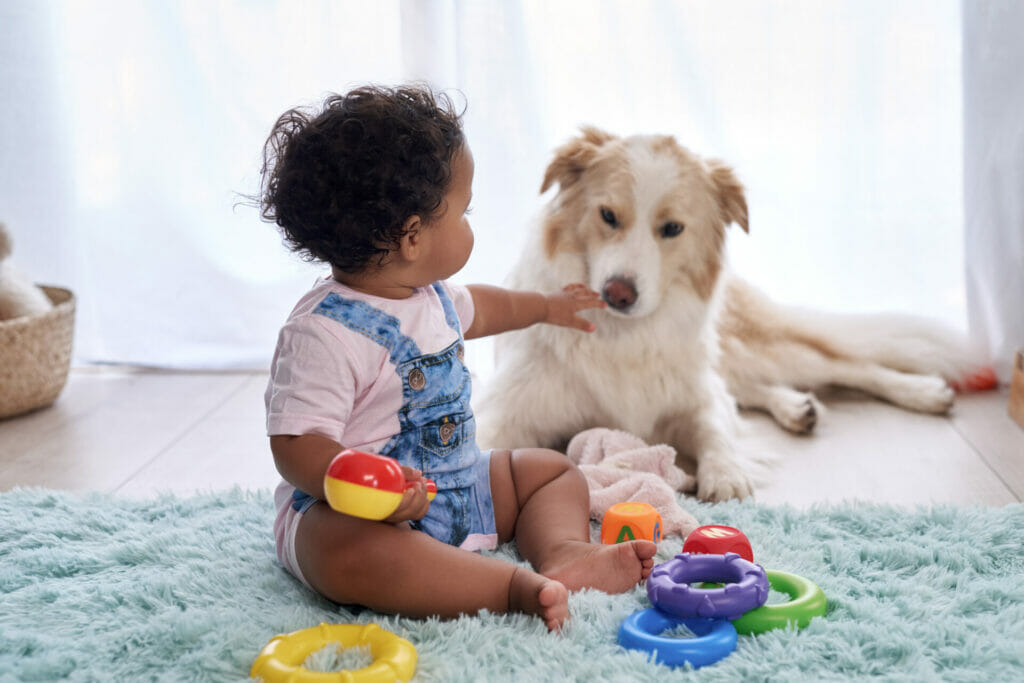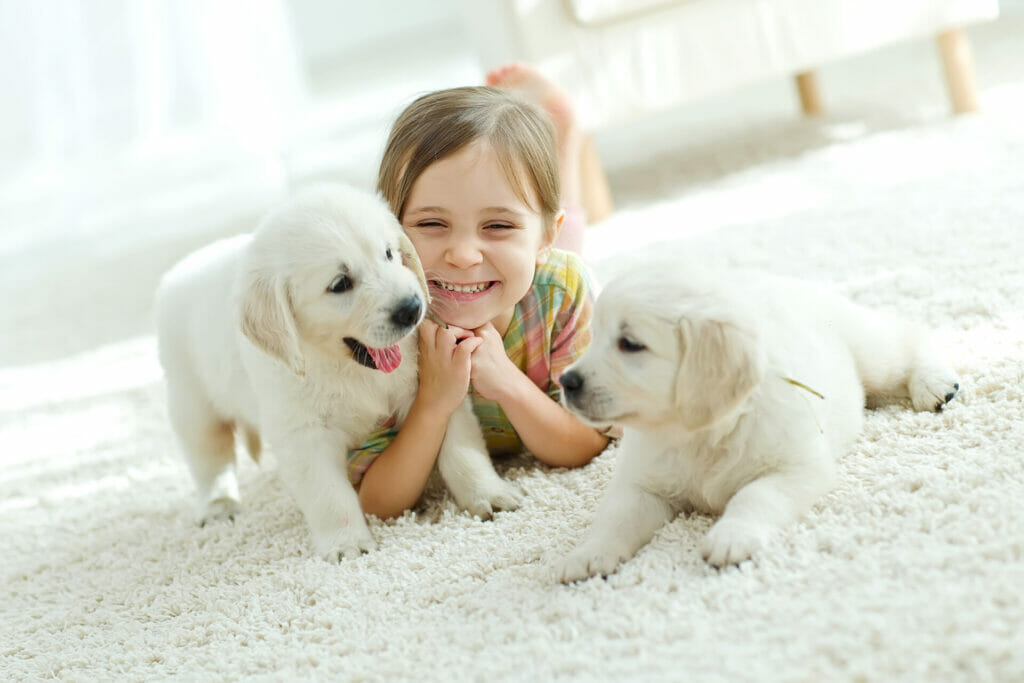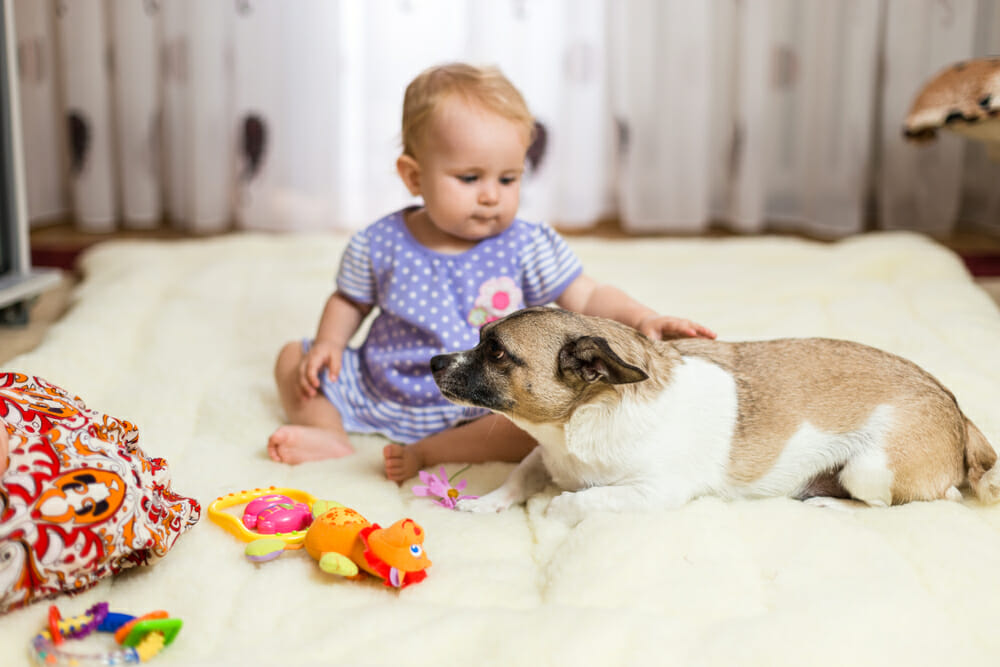One of the most significant issues that can come up if you have a dog and a baby is your dog taking your baby’s toys. This is a behavior we don’t want to encourage for sanitary reasons and because your dog and baby need to have their own belongings. There are also safety concerns about dogs playing with your baby’s toys. Baby toys aren’t as sturdy as dog toys and can lead to dogs chewing off bits of the toy, which can lead to intestinal blockages or be a choking hazard for both them and the baby.
Prevent Access To Your Baby’s Toys:
The most effective way to prevent your dog from taking your baby’s toys is to set your dog up for success from the start. To do this, we want to use environmental management to prevent your dog from accessing the toys. To do this, it’s helpful to use baby gates to section off areas of your home, like the baby’s room, to prevent your dog from having access.
Keeping your dog out of your baby’s room is an easy way to prevent your dog from having access to children’s toys. Similarly, if your kids have a playroom or play area in the home, you’ll want to use a baby gate to keep your dog out. As your baby gets older, you can begin to teach your child that it’s essential to put their toys back in their room to prevent the dog from contracting the toys.
Provide Enrichment:
In addition to setting your dog up for success by keeping your baby’s toys in locations where your dog won’t be able to get them, it’s essential to ensure that your dog has enough toys of their own. Dog-safe and appropriate toys and chews can help your dog get enough mental enrichment. A bored dog is more likely to find ways to entertain themselves, which may look like searching for toys. Making sure your dog has plenty of their toys and chews can help keep your dog from trying to play with the baby’s toys.
Teach Your Dog To Trade:
At one point or another, your dog will end up with a baby toy in their mouth. At this moment, your first instinct might be to lunge toward your dog and attempt to grab the toy away from your dog. However, doing so might get the toy away from your dog, or, more likely, because dogs are faster than us, it’s more likely your dog will take off running across the house with the baby toy in their mouth.

The more you chase your dog, the more your dog is likely to see this as a game of keep away. Instead of chasing after your dog, use these moments to teach or reinforce a “give” or “trade” cue.
To do this, have special high-value treats stored in easy-to-access locations around your house. Practice teaching trade first with your dog’s toys. When your dog has something in their mouth, show your dog the special high-value treats, and when your dog drops their toy, praise your dog and give them the high-value treat. After a few repetitions, you can add verbal cues like “drop” or “trade” as you present the treat to your dog. The goal here is for your dog to understand that you aren’t trying to take good things from them; instead, you will always give them something better.
Accidents Happen:
As dogs are increasingly seen as furry kids, more and more their playthings have come to resemble the toys that are sold for children. As a result, many baby toys look a lot like dog toys, and a lot of dog toys reach the toys you may be purchasing for your baby. If you’re confused about whose toys are whose, it’s no surprise your dog isn’t going to know what belongs to them.
Accidents are going to happen, and at some point, your dog is likely going to find a toy that doesn’t belong to them and try to play with it. In this situation, even if you’re frustrated, it’s important not to punish your dog. Remember, your dog doesn’t know that they have done something wrong. Your baby’s toys look like dog toys, and it’s important not to punish your dog for taking or chewing up a toy.

Your dog taking or playing with baby toys can be challenging. Taking and playing with toys is self-rewarding for dogs, and people can be frustrated by the behavior. The best way to handle your dog wanting to play with the baby toys is to prevent it from happening. As much as possible, keep baby toys in areas of the home where your dog can’t access them.
Then, make sure that your dog has enough of their own toys and chews to keep them occupied. Even if you attempt to keep toys away from your dog, at some point, your dog will find a baby toy. Teaching your dog to trade you the toy for a high-value treat can help to remove the conflict between you and your dog and get your baby’s toys back quickly.




















